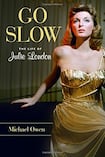
Talk about typecasting. Despite recording and releasing more than 30 albums of jazz/pop standards during the 1950s and 1960s, Californian-born Julie London is best known for one song, Cry Me a River, written by budding songwriter and friend Arthur Hamilton. London recorded the song in 1955, and performed it in the 1956 film The Girl Can't Help It. The song went on to sell more than a million copies, and became so synonymous with London that she was never able (or allowed) to abandon it.
London was born Nancy Gayle Peck, in Santa Rosa, California, on September 26th, 1926. Her family moved to Hollywood in 1941. It was here, in 1943, that Peck’s movie-star looks – apparent even in her day job of elevator operator at Roos Bros clothing store – caught the eye of talent agent Sue Carol, wife of Hollywood heart throb Alan Ladd. Carol advised a name change (London was chosen, suggests author Owen, to capitalise on “the potential publicity of seeing and hearing the name of the British capital amid the patriotism of a world at war”). The following 10 years were taken up a sequence of appearances in underperforming movies, where her roles were, at best, secondary. Come the mid-1950s, London made a career change, making her amateur after-hours singing hobby her day job.
From stage to studio
London, who by this time was in a relationship with jazz pianist and songwriter Bobby Troup – best known for the pop standard (Get your Kicks On) Route 66 – was persuaded by him to make her public debut at Hollywood's ritzy 881 Club. It was a huge success – her initial three-week engagement stretched to three months. It was after one of these shows that Liberty Records founder Si Waronker approached her and signed her to his label.
What worked in a live setting – a mixture of shyness, beauty, naivety and intimacy – was initially deemed problematic for studio recording. Waranoker needn’t have worried. In order to counteract London’s lack of vocal projection, at her first recording session she was asked by the studio engineer to move her mouth almost on to the microphone. The aural effect heightened the husky quality of her singing voice, and the recorded result gave the impression that she was singing only to the listener.
To her long-term irritation, London was permanently stuck with this illusory notion, which was also tethered to her physical appearance. According to Linda Wheeler, one of her backing singers and best friends, projecting sex was a sizeable aspect of her image, if not commercial appeal. “When she got in a low-cut gown and started singing that breathy-quality kind of sound, it was just sex in a bottle.” Rather more crudely, Billboard critic Robert Sobel described her club act as displaying “the organised abandon of a top stripper”.
Sultry wave of success
For several years London rode the sultry wave of success for all it was worth. The end was in sight, however. In 1966, as she turned 40, her stylised singing and performing – still much admired by the lounge clientele of large cities in the US – simply didn’t register with baby boomers in love with The Beatles and The Beach Boys. And so she reverted from singing to being in front of the cameras again – albeit on television instead of film – and then into a form of wilful, welcoming domestic obscurity. “You gotta have the ego for it, and I never did,” said London of her career to Canadian journalist Jim Bawden in 1972.
Such an attitude sums up London’s unpremeditated career as a self-aware stylist, tolerant sex symbol and frustrated actor. “There’s always something just around the corner for people to run into,” she told an interviewer. “But I haven’t the foggiest what or where my corner is.”
Despite her uncertainty, this sincere, well-researched biography highlights that London at her best could join the ranks of Peggy Lee and Lena Horne as one of America’s great ladies of song. She once noted that her record labels spent more time strategically designing her album covers than caring about the music, yet her virtue was her voice. Perhaps her error, author Owen implies, was being born too early for her creative talents to be truly recognised.












